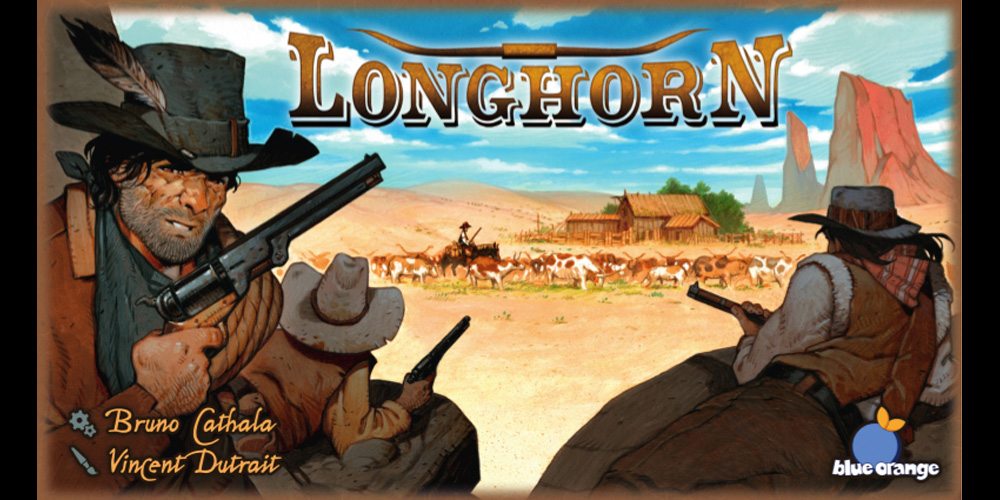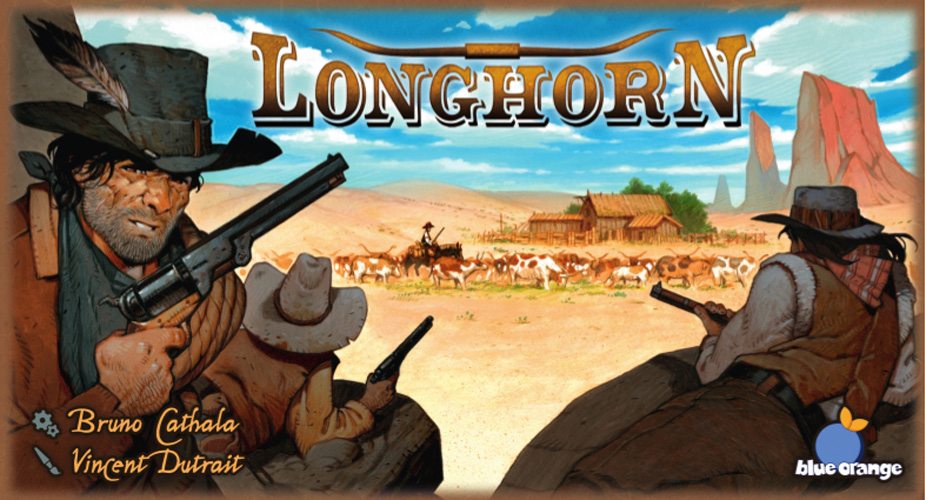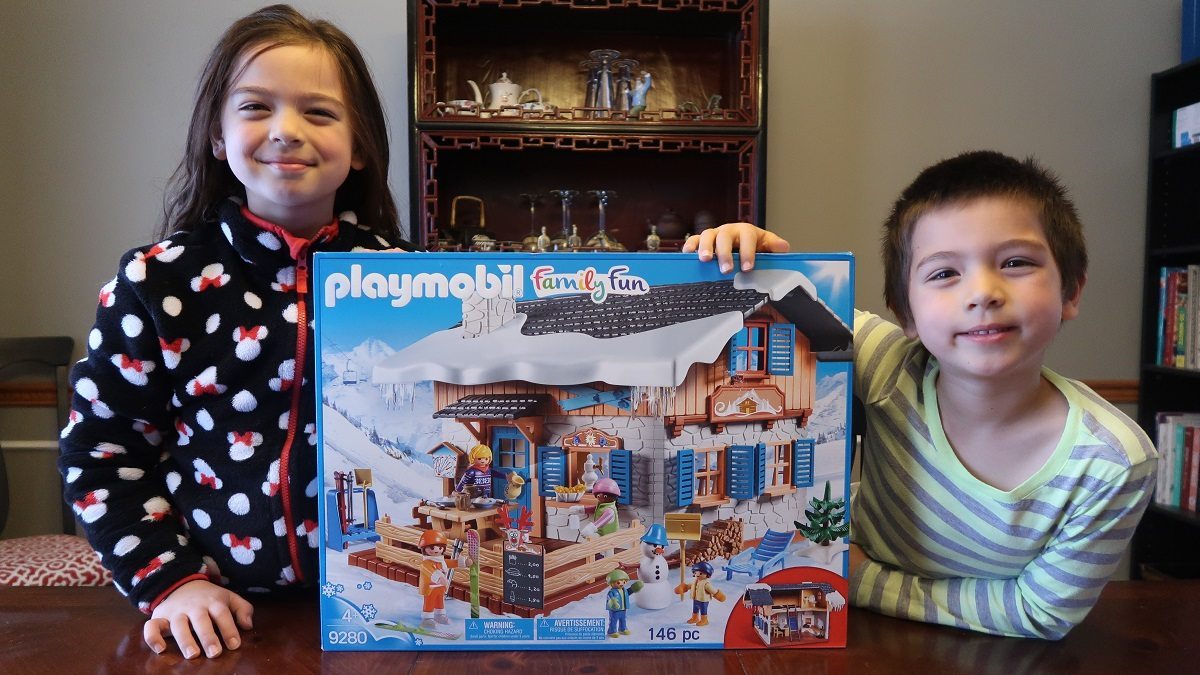“Table for Two” focuses on board games designed specifically for two players. It’s been a little while since my last “Table for Two” column, but I’ve got a couple to introduce to you. Today’s game: Longhorn, a game about two outlaws competing to rustle some cattle.
At a glance: Longhorn is for 2 players, ages 8 and up, and takes about 15 minutes to play. It retails for $24.99, and was published by Blue Orange Games as part of their Europe Collection, expanding from easier kids-only games to games with a little more strategic depth.
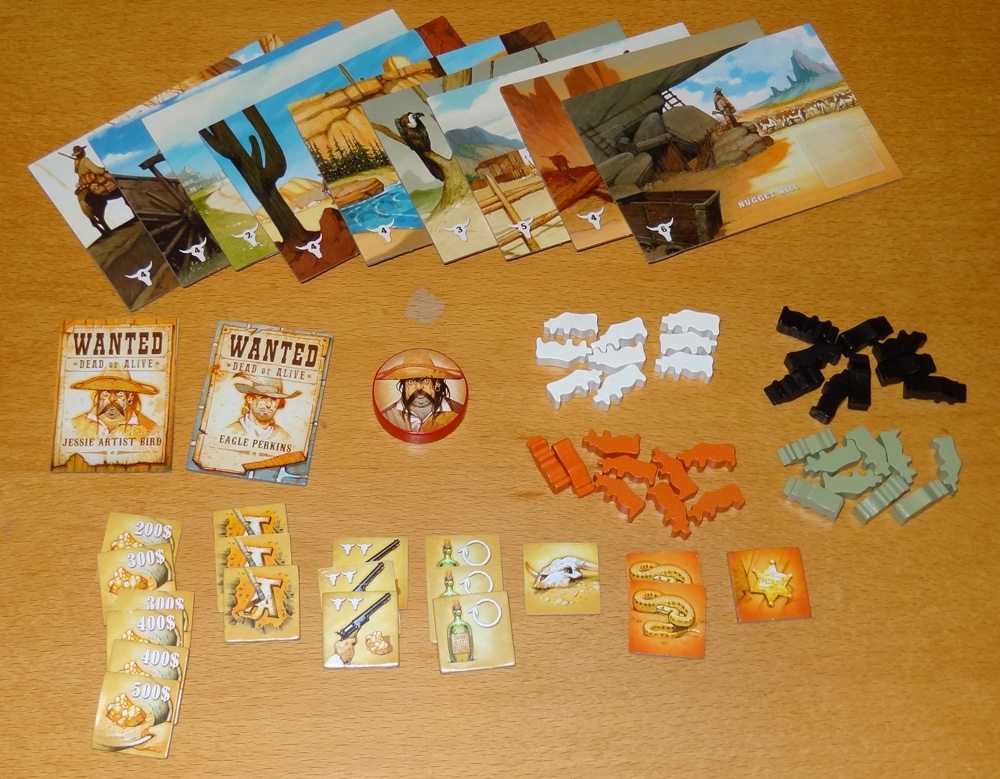
Components
Longhorn comes with:
- 9 Location tiles
- 19 Action tokens
- 2 Wanted tiles
- 1 Outlaw token
- 36 Cows (9 each in 4 colors)
The Location tiles are large cardboard rectangles, about the size of an index card. Each one has a name, a small cow skull icon with a number, and a square in one corner; the majority of the tile is artwork depicting the location. They’re double-sided, though with the same thing on both sides. I did find that some of my Location tiles were very slightly warped, which makes them wiggle a little when on a hard table.
The Action tokens are small cardboard tiles that fit on the squares of the location tiles. They just have images on them–you’ll have to refer to the rulebook for what each one does. They are color-coded, though: the hazardous tiles have a darker orange background instead of the light tan background.
The Wanted tiles just depict the two outlaws, and are just used to track which player is which: Eagle Perkins or Jessie Artist Bird. (That latter is kind of a weird name to me, but it’s not really important to the gameplay.) The Outlaw token is a large wooden disk with an image of one outlaw on each side.
Finally, the cows are little wooden meeples in black, white, orange, and a greenish-grey color, perhaps chosen for ease of distinguishing them rather than any sort of verisimilitude.
Overall, the components are pretty nice, aside from the slight warping. Mostly I found that the components seem bigger than absolutely necessary, although the whole thing still comes in a slim box. The artwork by Vincent Dutrait is nicely done and evocative of the old West.

How to Play
You can download a copy of the rules here.
The goal of the game is to have the most money at the end of the game by collecting cattle and gold nuggets–or to have your opponent arrested.
To set up, first randomly arrange the Locations in a 3×3 grid. Give each player a Wanted token indicating which outlaw they’ll be playing. Mix up the Action tiles and randomly choose 9 of them to place on the Locations. If the Sheriff token is present, it must be on Nugget Hill. Then mix up the cows and place the indicated number on each Location.
Flip the Outlaw token to decide which player will go first. The second player gets to decide where the first player will start, choosing one of the locations with 4 cows, and places the Outlaw token there.
On your turn, you do two things: steal cattle, and move the Outlaw token.
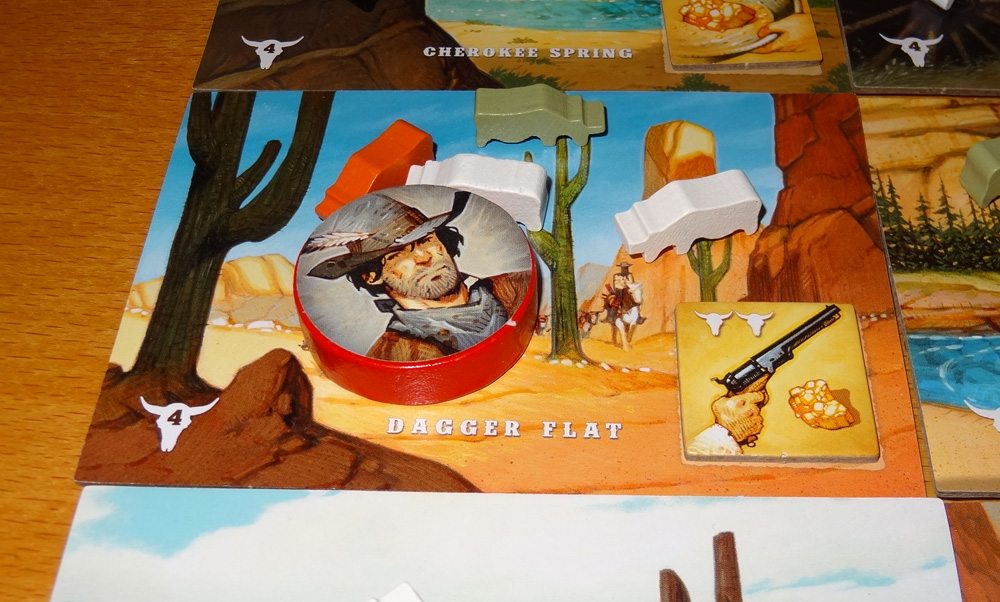
Steal Cattle: Pick a color, and take all of the cattle of that color from your Location. If there are no cattle left after you steal, then you must resolve the Action token from that location.
Move Outlaw Token: You must move the Outlaw token (orthogonally) a number of spaces equal to the number of cows you just stole, and then flip it over to indicate it’s the other player’s turn. You must place it on a Location that still contains cows, and you may not double back while moving. Also: you may not send the same player to the same hazardous Action token twice in a row unless no other options exist.
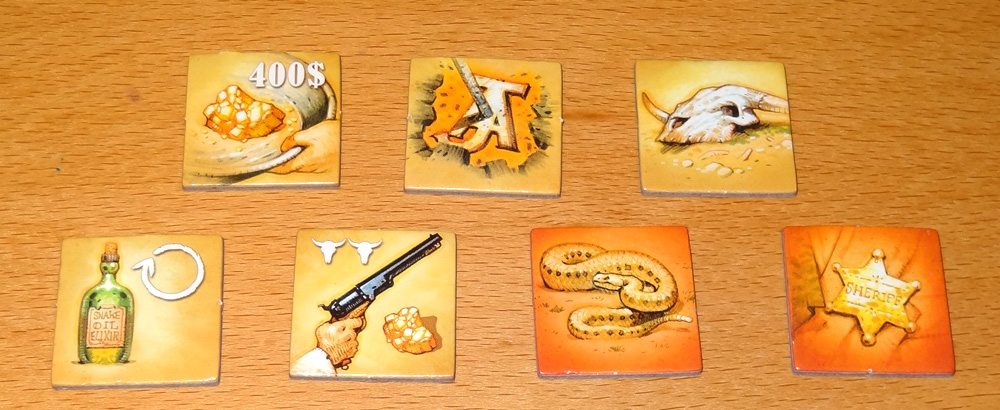
Here are the various Action tokens:
- Gold Nuggets: take the token; the gold value is added to your score.
- Branding Iron: steal all the cattle of the same color on an adjacent tile. (If this empties the adjacent tile, that Action token is just discarded without effect.)
- Epidemic: choose a color, and remove all cows of that color from the entire board. (This will make that color worthless at the end of the game.)
- Snake Oil: take an additional turn after moving the Outlaw token.
- Ambush: steal a gold nugget (at random) or two cows of the same color from your opponent.
- Rattlesnake: your herd panics; take one cow of each color from your herd, and distribute them on adjacent Locations however you wish.
- Sheriff: you’ve been arrested and you lose the game.

There are three ways the game can end:
- An outlaw takes the last cow from Nugget Hill and is arrested by the Sheriff–the other player wins.
- An outlaw collects all 9 cows of a single color, and wins the game (unless this causes an arrest).
- The Outlaw token cannot be moved to a location that still has cattle. Calculate scores to determine the winner.
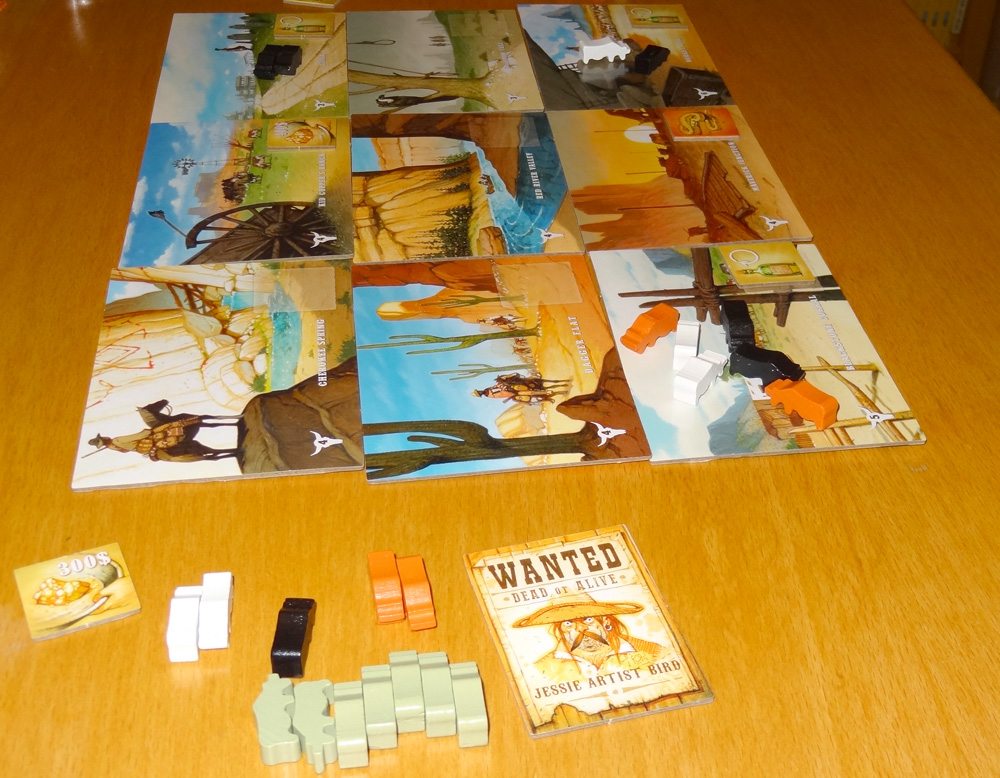
To calculate your score, each cow in your herd is worth $100 for each cow of that color remaining on the board. So if you have 3 orange cows and there are 4 left on the board, you have a total of 3 x $400 = $1,200. However, if you have 6 orange cows and there’s only 1 left on the board, they’re worth 6 x $100 = $600. Finally, add your gold nugget values to get your total score. Higher score wins.
The Verdict
Longhorn is a quick little game, and with the randomized Location tiles, Action tiles, and cattle, every game will play out a little differently. As in Niya, another two-player game by Bruno Cathala, a lot of the strategy comes in trying to maneuver your opponent, trying to read ahead the possibilities of where that will leave you on your next turn. In general, you don’t want to send them to any tiles where there’s a good Action tile and only one color of cows left. But eventually you’ll have to, so you try to plan ahead for which one you’ll send them to, and whether you can benefit from where they will move you after that.
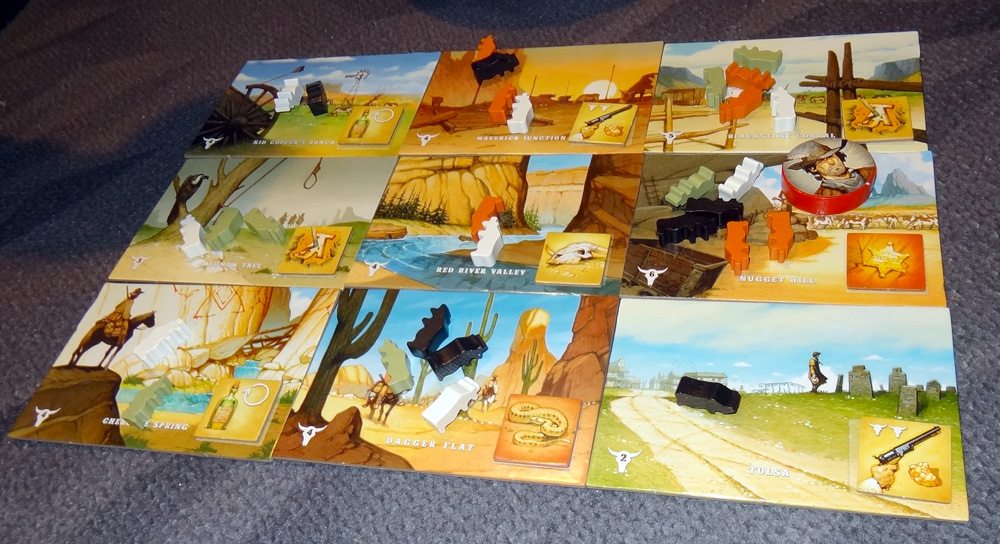
The scoring for the cattle is also quite interesting. Since your cows are worth $100 for each cow of that color left on the board, your goal is to take some of each color, but not too many, so they’ll be more valuable. Or, you can shoot the moon and try to get all 9 to win the game, but that means trying to avoid placing your opponent on that color, which can be quite difficult. Meanwhile, if you see your opponent collecting a color, it’s usually to your benefit to take some, too, even though you know that’s just driving the price down even further. Striking the right balance for score is incredibly tricky, and is a lot of fun to think about.
Of the Action tokens, the “take another turn” Snake Oil seems a little overpowered at first. In a short game with only so many turns, an extra turn can be a powerful thing. On the other hand, when played correctly, it can force somebody to take a color they don’t want, or to send you somewhere they didn’t want you to go.
The board is small–a 3×3 square doesn’t leave a lot of places to go–and so it forces both players to dance around, trying to decide which Locations to avoid.
I’ve played this with both adults and kids, and it’s been fun with both types of gamers. It does appeal more to those who like chess-type games, since you’re against a single opponent and so it’s easier to figure the available options for movement. It’s also a perfect information game–everything about the game is right there on the table, with no secret information. The only luck is in the setup of the game and choosing a first player. After that, everything is based on choices. That may make it hard for less experienced players, because it is a game that you win based on skill and not on luck. However, because it’s a short game, it’s also one that can be picked up and played, and I think will not result in very significant disappointment for the loser.
Overall, a nice little game for two. Look for it at your local game store, order through Blue Orange’s website, or pick up a copy on Amazon.
Disclosure: I received a review copy of this game.
